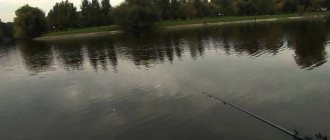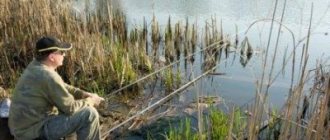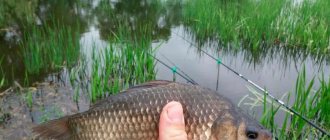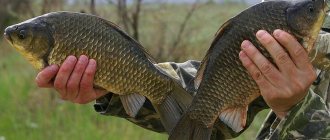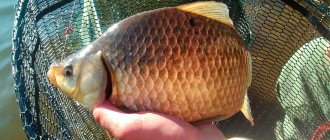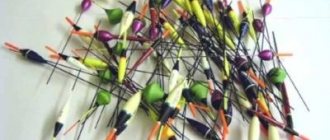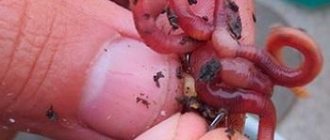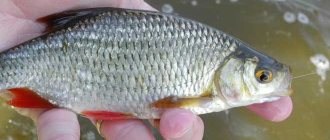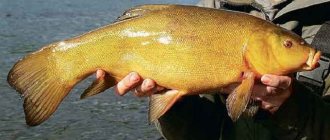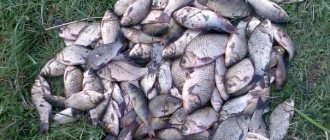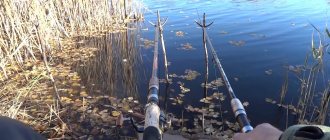Home > Spring fishing > Catching crucian carp in spring - the secrets and subtleties of fishing with a float rod
Fishing for crucian carp in the spring is very popular with almost all anglers. This fish is the object of not only amateur, but also sport fishing. Crucian carp is found in any body of water, regardless of the size and purity of the water, sometimes reaching very impressive sizes of 1.5-2 kg. One of the simplest and most popular gear for catching crucian carp in the spring is considered to be a regular float rod. Today, stores offer a wide selection of fishing rods and other elements, which allows you to choose gear in accordance with the requirements of the fisherman and fishing conditions.
Finding fish in a pond
After water bodies are cleared of ice, crucian carp leave their wintering grounds and begin to actively feed. It is attracted to places with well-heated water and plenty of food. At the beginning of spring, it is found in shallow coastal areas with a depth of 20-100 cm. In the second half of spring, when the water temperature rises, the fish begins to move to depth, moving further and further from the shore.
The main places for catching crucian carp in the spring:
• the tops of the edges, located next to the gently sloping shore; • areas of shallow water in the coastal zone, abundantly overgrown with grass and reeds, which are flooded during the spring flood; • thickets of algae and reeds up to 1-1.5 meters deep; • hills and shallow snags where crucian carp can easily find shelter in case of danger.
Typically, active biting of crucian carp is observed until mid-May. After this, it begins to spawn, and the bite practically stops - only small crucian carp are caught.
Features of catching crucian carp on a float depending on the month
Spring fishing for crucian carp differs in each month of the season due to rapidly changing weather and natural conditions.
If the winter was cold, the reservoirs where crucian carp live are often still covered with ice in March. Near the shore, it begins to melt, which means that with the melt water, oxygen penetrates under the ice, which the crucian carp so lacked. It makes the fish active. It swims around the reservoir in search of food, so you can catch it both in the coastal zone and in the depths. The main catch in March is bloodworms.
With the onset of April warmth, the fisherman needs to pay special attention to the coastal zone. During this period, the water warms up well, which means that the crucian carp has already moved there. Bloodworms, fatty dung worms, and maggots are perfect for bait. The bite lasts all day.
Fishing in May can last until the middle of the month or until the first days of June - depending on the upcoming spawning, which begins only when the water temperature reaches 6 degrees. As the algae grows, the crucian carp begins to pay attention to plant baits. If May turns out to be hot, then fishing will be successful only in the mornings and evenings.
Article on the topic: Crucian fish
Selection and equipment of a float rod
The wrong choice of gear can negatively affect your fishing results. Even a regular float rod has various modifications designed for different fishing conditions.
Rod selection
There are four main types of rods designed for float fishing. When choosing, the angler should focus both on the ease of handling the gear, and on the characteristics of the reservoir and the behavior of the crucian carp.
Types of fishing rods:
1. Bologna. A very easy to use and inexpensive telescopic fishing rod. It has a reel holder and guide rings, so it makes it possible to fish at different distances from the shore. Very common among beginners and amateur fishermen. The optimal length for catching crucian carp is 4-4.5 meters.
2. Flywheel. A telescopic fishing rod with a minimum number of elements - there are no rings or a reel, a fishing line of a certain length is attached to the end. The casting distance depends on the length of the fishing line with the rod. They can be up to 7 meters long, but for crucian carp they usually take rods from 4 to 5 meters.
3. Match. It has a large number of guide rings and a reel seat. Makes it possible to cast over long distances with a high-quality reel with an easy and smooth stroke. To catch crucian carp in the spring, a rod up to 5 meters in length is sufficient, but the distance from the shore to the fishing point is taken into account - the longer the rod, the farther you can cast the hooks. 4. Plug-in. It is used mainly by professional fishermen, as it requires certain handling skills. It is a fishing rod that is assembled from separate parts and can reach a length of 16 meters. There is no reel or guide rings; a small piece of fishing line with equipment is tied at the end of the fishing rod. It makes it possible to silently and accurately lower hooks into the water in the right place, so it is well suited for catching cautious crucian carp in early spring.
When choosing a fishing rod, you also need to pay attention to the material - tackle made of carbon fiber or fiberglass will be very light, but at the same time have a sufficient margin of strength.
Coil selection
The reel, first of all, must be reliable, and all its elements must be of high quality. Fishing for crucian carp in spring occurs in thickets of reeds and grass, and frequent hooks significantly increase the load on the reel. You can put absolutely any reel on a Bolognese fishing rod – the angler’s choice. When fishing with a match fishing rod, you should use a reliable spinning reel that has a good friction brake. Spool size – 1500-3000.
fishing line
In spring, crucian carp remain wary of winter, so the fishing line should be thin and inconspicuous. It is best to take fluorocarbon monofilament with a diameter of 0.14-0.18 mm.
When choosing a cheaper regular monofilament line, you should consider the following points:
- In thickets of reeds or underwater grass with a high probability of snags, monofilament with a diameter of 0.20 mm is suitable. Vegetation camouflages the fishing line well, making it invisible to the fish.
- For long-distance casting there is a special black line that quickly sinks in the water.
- For open areas, you should use as thin a monofilament as possible, the thickness of which depends on the size of the crucian carp in the pond and is usually 0.12-0.16 mm.
Braid is also suitable for a float fishing rod, which, while having the same strength as monofilament, has a smaller thickness. In this case, it is necessary to take into account the lack of elongation, which is characteristic only of monofilament fishing line.
Leashes are made from a fishing line with a smaller diameter than the main one. Ideally, they are made of fluorocarbon, but monofilament 0.08-0.12 mm thick can also be installed.
Floats
It is best to use ordinary spindle-shaped floats for crucian carp. Weight depends on the gear used:
- on a long-casting mast fishing rod they place large, clearly visible floats weighing up to 14-15 grams, secured in a sliding manner;
- the lightest floats weighing up to 1 gram are placed on flywheel and plug-in gear, which can ensure silent immersion of the equipment;
- floats from 3 to 5 grams are used most often and are placed on Bolognese fishing rods using a blind or sliding method.
Weight
The float is surrounded so that the body is completely hidden under water, leaving only the antenna on the surface. Small lead pellets are used as a sinker, attached to the end of the main line in front of the leash. Their mass and quantity depend on the size of the float.
Selection of hooks
Large hooks are not suitable for crucian carp - they are too noticeable in the water. Therefore, small hooks are placed, the size of which depends on the size of the fish and varies between 8-18 numbers according to the international table.
There is a dependence of the hook number on the bait used - the smallest ones are used when fishing for maggots and bloodworms, while larger ones are used for plant bait and worms.
Lure
Bait is an integral part of spring crucian fishing. Its main task is to attract, not saturate, fish, and keep them in one place for as long as possible. Therefore, all components included in the composition must be thoroughly crushed. In this case, the crucian carp, attracted by the nutrient cloud, will stand in place for a long time, unable to get enough of the small fraction.
Also, bait must be added to the bait mixture - usually bloodworms, maggots or chopped dung worms.
Recipes for catchy spring baits
Recipe 1: – 0.5 kg breadcrumbs; – 0.5 kg of ground oat flakes “Hercules”; - animal bait. The crackers and flakes are mixed, and at the pond, bait is added to the mixture and mixed with water from the reservoir. Also, to reduce nutritional value, you can add clay or soil.
Recipe 2: – 2 parts breadcrumbs; – 1 part of ground feed; – 1 part of chopped meat; – parts of powdered milk; – parts of sunflower seeds.
The components are crushed and mixed until smooth. Before use, you can add bait and mix the mixture with water. After reaching the desired consistency, make small balls from the mixture and roll in corn or pea flour and throw in.
There are quite a lot of bait recipes - each fisherman has his own secrets and secret proportions.
In addition to the above herbal components, you can also use: – makha; – various porridges – pearl barley, semolina, wheat, barley; - cookie; - boiled potatoes.
Flavorings in spring bait can do more harm than good - crucian carp react sharply to sharp and abundant odors during this period. Therefore, the usual natural odors that are contained in the plant ingredients of the bait mixture are sufficient: – corn and pea flour; – makukha; – sunflower seeds. Special commercial mixtures can also be used by adding a small amount of bait.
Bait for catching crucian carp in spring
Omnivorous crucian carp in spring prefers high-calorie foods rich in proteins. The most catchy are considered:
- red worm;
- maggot;
- bloodworm;
- caddisfly
In the second half of spring, fish willingly take plant foods:
- dough;
- steamed pearl barley;
- semolina and mash from it.
When preparing the dough, it is better to take pea or corn flour, as well as semolina and mix with egg yolk. For scent, you can add a drop of sunflower oil.
The main types of bait for crucian carp in spring
Spring crucian carp does not take all baits. The choice depends on the water temperature. So, on a float rod in early spring, when the water is not yet too warmed up, crucian carp are best taken with bait such as:
- Bloodworm.
- Maggot.
- Muckworm.
An increase in water temperature at the end of May increases his interest in plant foods. At this time, along with baits, he also prefers the following baits:
- Semolina chatter;
- Pea porridge;
- Steamed peas;
- Dough;
- Pearl barley;
- Canned corn.
A particularly popular bait is “Semolina chatterbox” , the recipe and preparation process of which you can see in the following video:
When the bite is weak and uncertain, many fishermen use combination baits such as “sandwiches”. This bait consists of bait and attachments of plant origin:
- Corn + bloodworms.
- Peas + bloodworms.
- Corn + worm.
Video: the best bait for crucian carp - preparation and use
Tactics for catching crucian carp in spring
Catching crucian carp in the spring with float tackle is not particularly difficult. After choosing a place, you should start feeding. To do this, throw 6-7 balls of bait into the water - not far from the shore this can be done by hand, at a long distance a slingshot will do. After about 30-60 minutes, you can throw out the gear and start fishing.
You can fish with several fishing rods at once, without forgetting to carefully watch the floats. The signal for hooking is the float moving to the side or diving into the water - this means that the fish has thoroughly swallowed the hook.
Fishing should be done smoothly - the soft lips of the crucian carp are easily torn off. It is also important to carefully remove the fish from the grass thickets to avoid catching and losing the prey, and then continue fishing more confidently.
Specifics of fishing for crucian carp from the shore, boat and at night on a float
In spring, crucian carp are caught both from the shore and from a boat. Each type of fishing has its own characteristics.
Coastal
Catching crucian carp in the spring from the shore using a float is the most common and popular type of fishing. Unlike fishing from a watercraft, coastal fishing has such features as:
- Long rods – when fishing from the shore, rods up to 7-8 meters long are used.
- Thin rigs - in spring, in clear water, the thinnest and strongest fishing lines and small floats with a low load are suitable.
- Using two or more gear – coastal fishing allows you to use a large number of gear. The main thing when choosing fishing rods is to remember the legality of their use at a given time of the year - it is better to see in advance how many tackles and hooks are allowed by the rules of recreational fishing in a given period.
Video: fishing for crucian carp in spring using a float rod from the shore
From the boat
Fishing for crucian carp from a boat is not as popular as compared to shore fishing. Compared to the previous one, this type of fishing has the following characteristic features:
- Short rods - when fishing for crucian carp from a boat, use short side or telescopic rods no more than 3 meters long.
- Coarser rigs – bites often occur from large individuals, which require thicker and stronger rigs to fish them out.
- The depth is greater than when fishing on the shore - when fishing from a boat, the depth should be at least 2.0 meters, since at this time of year the crucian carp, in shallow depths, is very frightened by the silhouette of the boat moving directly above it.
Fishing for crucian carp from a boat in the spring is relevant in May, when, due to excessive warming of the water, the fish gradually move away from coastal shallow waters to remote deep-water areas.
Night fishing
Catching crucian carp at night with a float rod is practiced in warm spring. The best time for such fishing is the second half of May. Unlike daytime fishing, night fishing has a number of features:
- the night must be warm enough , without heavy rain, wind or thunderstorms.
- Preliminary feeding - at night, crucian carp are even more timid and cautious, so they are fed several hours before the start of fishing, so that by the time it starts, the fish has already calmed down after splashes of bait falling into the water and approached it.
- Preparing the place - in order to avoid bumping into things and objects lying on the shore in the dark, even during daylight hours the fishing site is cleared of everything unnecessary, the necessary equipment and gear are placed nearby, and firewood is prepared for the fire for the whole night.
- Short fly rods - since at night crucian carp more boldly go to the coastal shallows, more convenient and lightweight short fly rods are used.
- Using a flashlight and luminous attachments – for fishing in the dark, it is imperative to use firefly attachments for floats and a powerful LED flashlight.
When fishing with a float in the spring, it is also worth remembering that crucian carp is not a weed fish species, therefore, having caught a small crucian carp, it should be released to grow back into the reservoir. This is not just a humane but also a rational attitude towards fishing - from a small crucian carp in the future a large and strong fish can grow, the capture of which will be a true fishing happiness.
Recommendations for increasing catch:
• Crucian carp can be quite picky in the spring, so you should stock up on several types of bait. • Hooks should be matched to the color of the bait. • It is convenient to fish thickets of reeds and reeds from a boat, using Bolognese tackle 3-4 meters long. • You can stick a little bait around the pellet weights - it will fall exactly into the location of the hooks. • Hooks that are too thin will easily tear the lips of a crucian carp. • It is better if the color of the bait matches the color of the soil at the bottom of the reservoir. • The most catchy vegetable bait is considered to be dough, which is very good for crucian carp to bite from mid-spring. • The rig can use one or two hooks. In the second case, they are often knitted on leashes of different lengths.
Fishing for crucian carp in spring begins when the water heats up above 60 C. Crucian carp at this time is very picky and careful, so the angler will need maximum effort to ensure a decent catch. A float rod does not require any special skills to use, so any novice fisherman can handle this tackle. The main thing is to study the habits and preferences of fish in the spring and thoroughly prepare for fishing.
Bite of crucian carp when fishing with a float rod
The crucian carp pulls the bait into its mouth and holds it there, as if savoring it and wondering whether it’s worth swallowing. At this moment, the float trembles slightly, but under no circumstances should you rush into hooking. You need to hook when, after light rocking, the float lies on the water or floats to the side. Sometimes it happens that the float suddenly sinks. The hook must be done carefully, as crucian carp have weak lips.
At the end of the article about catching crucian carp with a float rod, a few words about what depth you need to fish at. Most often they are caught from the bottom. The depth of the fishing rod is adjusted so that the bait with the hook lies on the bottom, but the float “stands.” When the bottom is covered with algae, you can raise the nozzle above the bottom by 10 centimeters.
Published: February 22, 2021, 19:33
- Tags:
- crucian carp
- nozzle
- fishing rod rig
- float rod
- lure

